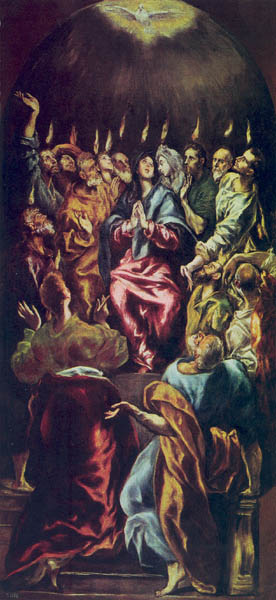Image Details

Scala/Art Resource, New York, NY
“Tongues as of fire” descend upon the apostles, who “were all filled with the Holy Spirit and began to speak in other tongues, as the Spirit gave them utterance” (Acts 2:3–4) at the first Christian celebration of Pentecost. This day, seven weeks after Passover, originally marked the end of the barley harvest and the beginning of the wheat harvest, but in Jewish tradition after the fall of the Temple in 70 C.E., it commemorated the day on which the Law was given at Mount Sinai.
El Greco (Domenikos Theotokopoulos, 1541–1614), a Cretan painter who flourished in Spain, painted this rendition of the miracle, Pentecost, in the last five years of his life. Although no dove appears in the biblical story, El Greco apparently placed it at the top to the picture to represent the Holy Spirit, because the dove embodies the Holy Spirit in the accounts of Jesus’ baptism (Matthew 3:16; Mark 1:10; Luke 3:22; John 1:32).
Defending the authenticity of this event against a disbelieving populace, Peter cites the prophet Joel, “And in the last days … I will pour out my Spirit upon all flesh” (Acts 2:17), a prophecy that Peter sees fulfilled in the Pentecost event. Various biblical commentaries among the Dead Sea Scrolls, including the Habakkuk Commentary (see photo of Habakkuk Commentary), also use this manner of scriptural interpretation, in which Old Testament prophecies are seen as applying to the Qumran sect and as pointing to the present (that is, the time of the scroll’s composition) as the predicted end-time.
